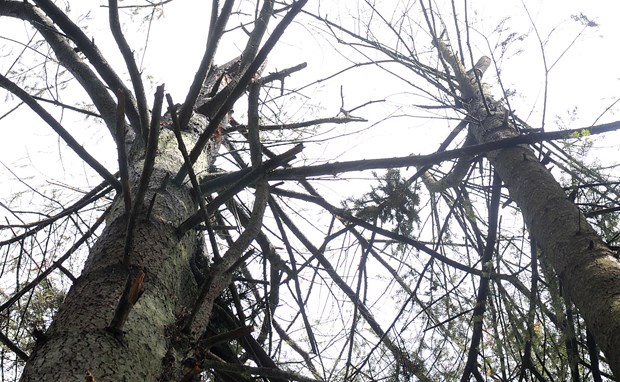West Vancouver council members may be hugging the district’s trees a little less tightly.
Council voted Monday night to strike a task force that will study in detail what West Vancouverites want to see in a tree bylaw, after a survey showed West Vancouverites are deeply divided over the new interim measures.
The interim bylaw, modelled after the District of North Vancouver’s, forbids the removal of trees with trunks 75 centimetres or more in diameter, unless an arborist deems them to be dangerous. But that approach was too heavy-handed, according to 48 per cent of respondents to the survey.
Residents on the western side of the municipality were far more likely to oppose any regulation on tree cutting at all, while Ambleside and Dundarave homeowners were more likely to favour new rules.
A host of residents turned out Monday night to give council an earful about how the interim bylaw was preventing them from responsibly maintaining their property, opening up an ocean view or allowing light to penetrate the canopy.
“There is no need for a bylaw to apply to homeowners who have no intention of building a monster home,” said Jackie Lane, an Eagle Harbour resident. “What does council have against light or ocean views?
They are the reason many people choose to live in West Vancouver. … Do not condemn us to the continual encroachment of the forest. We need some sunshine in our gardens.”
It was a sentiment also argued by residents in the British Properties, including John Ryckman, who noted that Burrard Inlet vistas have been a selling feature in the properties since the 1950s.
“I would argue (views) are in fact significantly more important than preservation of monster trees that can grow to 250 feet or more,” he said.
Christine Cassidy, however, wasn’t having any of it, noting she was probably the one who pushed hardest for the interim bylaw as a means to preserve the environment and character that most attracts people to live in West Vancouver.
“And I say ‘Thank you Christine Cassidy’ because I was sick and tired of listening to citizens coming here, complaining endlessly about the fact their council was doing nothing about the clear-cutting of properties,” she said. “We’ll get it right and we will listen to the majority but I’m not going to say ‘Sorry’ to anybody who, in the immediate, is inconvenienced. You should be saying ‘Thank you’ to us for preserving the environment that we hold so valuable.”
At its root, the interim bylaw is intended to counter the chainsaw-happy habits of developers in recent years, as real estate speculation has driven them to build the largest homes possible with unimpeded views, Coun. Mary-Ann Booth said.
“I certainly wouldn’t be fiddling with something that wasn’t broken if it wasn’t for the siege that many neighbourhoods are feeling around construction impacts to their neighbourhoods,” she said.
Mayor Michael Smith offered his own theory on why people choose to live in West Vancouver and urged council to step very carefully about taking on a huge public expense to “enforce an unenforceable bylaw.”
“I’ve always said I think West Van should be an island of sanity in a socialist sea. What I meant by that is you get away from all of the higher-purpose people and the nanny states that exist in so many areas in our lives. Here, people want to settle into their homes and be reasonably free of bureaucracy,” the mayor said.
Staff are expected to report back on the task force’s draft terms of reference and proposed membership this fall.



